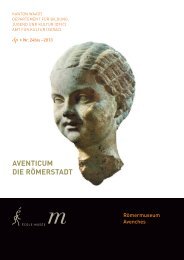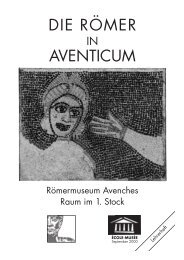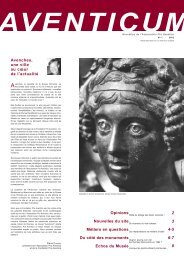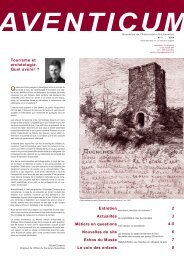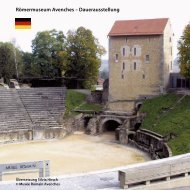Avenches – Roman Museum – Permanent Exhibition
Avenches – Roman Museum – Permanent Exhibition
Avenches – Roman Museum – Permanent Exhibition
Create successful ePaper yourself
Turn your PDF publications into a flip-book with our unique Google optimized e-Paper software.
Ground Floor The Inscriptions<br />
The Stone Inscriptions of <strong>Avenches</strong> / Aventicum<br />
role in administrative and political positions. The influence and personal interests<br />
of some families, therefore, determined the destiny of the town to a considerable<br />
extent.<br />
The numerous dedications show that, while the population took on the <strong>Roman</strong><br />
pantheon, they also maintained the Gallo-Celtic belief system. It is interesting that a<br />
relatively large number of people held an office as priests within the imperial cult.<br />
At least three roads leading into the town of Aventicum can be identified as socalled<br />
funerary roads lined with tombstones.<br />
Besides the fact that the design of the preserved tombstones was very varied,<br />
it is also striking that the inscriptions were relatively brief and some of them were<br />
engraved in a rather careless way. Some texts refer to the considerable financial<br />
commitment of individual people regarding the maintenance or extension of public<br />
buildings. It also stands out that the so-called scholae are mentioned rather often.<br />
They may have been honorary halls or gathering places. It seems that outstanding<br />
citizens of Aventicum were publicly honoured not only by erecting statues on<br />
pedestals with inscriptions but also by granting them permission to erect a schola.<br />
17. Architrave with dedication (1)<br />
Donated by the navigators on the Aar and the Aramus in honour of the imperial family<br />
Limestone. Discovered east of insula 33 at the edge of the forum.<br />
Late 2nd century AD. Catalogue of inscriptions no. 9.<br />
18. Base of a statue with dedication in honour of Quintus Cluvius Macer<br />
Limestone. Discovered in the eastern section of insula 28, the eastern portico of the<br />
forum.<br />
Second quarter or mid 2nd century AD. Catalogue of inscriptions no. 7.<br />
19. Capital of pilaster with dedication to the Lugoves (2)<br />
Limestone. Lugoves are Celtic gods who can be equated with Mars and Mercury.<br />
The capital served as a pedestal for several statues<br />
Discovered between the enclosures of the Grange des Dîmes and the Cigognier temples.<br />
Late 2nd or early 3rd century AD. Catalogue of inscriptions no. 2.<br />
20. Architrave with inscription commemorating the construction of a hall for ball games<br />
Limestone. Discovered between insula 19 and the enclosure of the Grange des Dîmes<br />
temple.<br />
First half of the 2nd century AD. Catalogue of inscriptions no. 10.<br />
21. Altar with dedication to the goddess Aventia and to the genius of the townspeople<br />
(incolae) of <strong>Avenches</strong> (3)<br />
Limestone. Original location unknown.<br />
2nd <strong>–</strong> 3rd centuries AD. Catalogue of inscriptions no. 18<br />
22. Marble dedication to the goddess Aventia<br />
Original location unknown.<br />
2nd <strong>–</strong> 3rd centuries AD. Catalogue of inscriptions no. 17.<br />
23. Altar with dedication offered to doctors and teachers<br />
Limestone. Original location unknown.<br />
Second half of the 2nd or early 3rd century AD. Catalogue of inscriptions no. 4.<br />
1<br />
2<br />
3<br />
18<br />
Ground Floor



